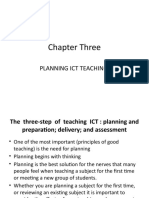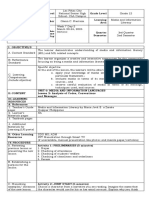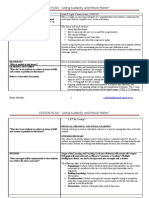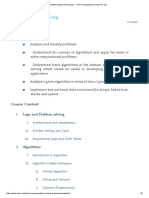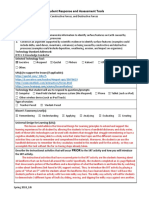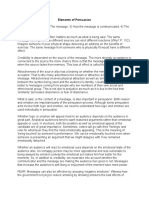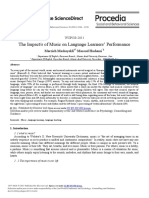Ict Lesson Plan
Ict Lesson Plan
Uploaded by
api-296538575Copyright:
Available Formats
Ict Lesson Plan
Ict Lesson Plan
Uploaded by
api-296538575Original Title
Copyright
Available Formats
Share this document
Did you find this document useful?
Is this content inappropriate?
Copyright:
Available Formats
Ict Lesson Plan
Ict Lesson Plan
Uploaded by
api-296538575Copyright:
Available Formats
EDUC3625 Numeracy and ICT Assignment 3 IWB Lesson Plan
Lesson Plan.
On the Move: Pushes and Pulls.
Name: Myriah Smith (2108100), Denielle Atkin (2107113) & Taylar Cox
(2083213)
Year Level: Reception
ACARA Science Content Descriptor:
Science Understanding > Physical Sciences > The way objects
move depends on a variety of factors, including their size and
shape (ACSSU005).
Science as a Human Endeavour > Nature and development of
Science > Science involves exploring and observing the world
using the senses (ACSHE013).
Science Inquiry Skills > Planning and conducting > Explore
and make observations by using the senses (ACSIS011).
Science Inquiry Skills> Processing and Analysing data and
information > Engage in discussions about observations and
use methods such as drawing and representing ideas
(ACSIS233).
Science Inquiry Skills> Communicating> Share observations
and ideas (ACSIS012).
ACARA ICT Content Descriptor:
Select and use hardware and software: Identify and safely
operate ICT systems to complete relevant, simple, specific
tasks, and seek help with encountering a problem.
Identify the impacts of ICT in society: Identify how they use
ICT in multiple ways on multiple devices.
ACARA Numeracy Content Descriptor:
Estimate and Measure with metric units: Measure by comparing
objects and indicate if these measurements are the same or
different.
Interpret data displays: Recognise how to ask and answer simple
data questions and interpret data in drawing or picture graphs.
Recognise and use patterns, and relationships: Describe and
continue patterns.
Required Resources:
- Primary Connections On the Move.
- SMART Notebook.
- BBC Interactive Learning Game:
http://www.bbc.co.uk/schools/scienceclips/ages/5_6/pushes_pu
lls.shtml.
Inquiry Question: How far do things roll with a soft and hard push?
EDUC3625 Numeracy and ICT Assignment 3 IWB Lesson Plan
Inquiry Learning Stage: Finding out.
Lessons number in this stage: 1
EDUC3625 Numeracy and ICT Assignment 3 IWB Lesson Plan
Connect/Starter
This part of the lesson should take 5 minutes.
5 min
How far do things roll with a soft and hard push?
Learning Objectives:
All students will...
- Understand that a push is a type of force that involves moving
something away from you and a pull is a type of force that involves
moving something towards you.
- Participate in investigation where students observe and gather evidence
about moving objects and explore the idea of fair testing.
- Use ICT to record and display results of a push or pull experiment.
Most Students will...
- Understand that why and how things move depends on a variety of
factors, including their shape and size.
- Begin to understand how and where pushes and pulls are used in their
everyday life.
Some Students will
- Begin to understand that Scientists use these concepts to design toys,
cars, and space craft, and to study human movement and athletic
performance.
This part of the lesson plan involves making learning personal and creating a
learning climate. Objectives are clearly defined, with connections between what
they already know and what they will know and have learnt by the end of the
lesson. Whole class discussion, interactive activities are used to stimulate
memorization of prior knowledge.
Lesson Steps:
1. Introduce and play the interactive game Pushes and Pulls using the IWB:
http://www.bbc.co.uk/schools/scienceclips/ages/5_6/pushes_pulls.shtml.
2. Help students become aware of prior knowledge by facilitating discussion,
pointing out key words students are using and asking questions such as:
- Why does that object move?
- What is a push? What is a pull?
- What do you think will happen if we do a hard push instead of a soft
push?
- Why is there a difference?
3. Discuss the idea that pushing is moving something away from you, and
pulling is moving something towards you.
4. Participate in the Interactive game using Smart Notebook. Students are to
match pictures of a movement to the correct word (push/pull).
Teaching strategy: Questioning.
The teacher is to use class discussion and the use of questioning to facilitate
learning. Using questions can help students to identify the numeracy and then
to apply the mathematics. The use of open questions can also provide
EDUC3625 Numeracy and ICT Assignment 3 IWB Lesson Plan
Activa te
This part of the lesson should take 20 minutes.
20 min This part of the lesson plan is where students begin to explore new knowledge, with
students engaging in investigations for them to experiment with themselves.
1. Word wall:
-
Ask students to describe the ways things move, and to recall key words they
have used in discussion.
Begin to create a word wall, to be added to throughout the topic.
2. Explain in this unit students will investigate things that move and how
they move:
-
Discuss students experiences of pushing toy cars. Introduce the question
How far do things roll with a soft and a hard push?.
Explain students will investigate how far a toy car will go using both a hard
and a soft push. Introduce the investigation equipment. Ask students to
predict what will happen with a soft push, and what will happen with a hard
push.
Model how to set up a starting line to test the soft and the hard push. Model
how to use the starting line (by placing the toy car up against the starting
line) and demonstrate a push.
Discuss the differences between a soft push and a hard push. Record
predictions and reasoning on SMART board.
Model an unfair test by placing the toy car over the starting line to begin the
push. Discuss what is meant by the word fair in science (that the same
things are to be kept the same) for example, releasing the object from the
same point every time.
Discuss that only one thing is changed during the experiment to keep it fair.
For example, the soft and hard push of the toy car.
Model how students will record videos, similar to previous lessons. Review
how to open the camera and select video mode. Model how to record a
video by pressing record and pointing the camera at the object in which
they wish to record. Explain this will be used to share their observations
with their classmates.
EDUC3625 Numeracy and ICT Assignment 3 IWB Lesson Plan
D emonstra te (Assessment for Learning)
This part of the lesson should take 20 minutes.
20 min This phase is where students demonstrate and share their new knowledge as
they head into deeper understanding. Students have activated knowledge and
are beginning to form conclusions.
Explain that the students will push their toy cars and use streamers, string or
Lego to measure how far they go. Demonstrate this with a streamer, by placing
one end of the streamer at the starting line, and tearing the other end where the
toy car landed, at the front of the car.
Explain the students will measure one hard and one soft push to record on the
class table on the SMART board.
Review how students will conduct fair tests. For example, the measurement is
from the starting line to the front of the car.
Allow students to measure their streamer against a ruler to get a centimeter
answer. They will then record this onto the SMART board. Ask the students
questions, such as how can we measure a streamer? to prompt thinking and
allowing them to work it out for themselves.
Students will chose a video of both a soft and a hard push to share with another
group.
Students will now share their videos with another pair. Explain they will need to
discuss, what they did, what they observed, what they changed and how they
measured.
Teaching strategy: Allowing them to work it out
Provide students with both individual and collaborative opportunities to work things out
for themselves and engage with the numeracy demands. This is done by allowing
students to explore different ways of measuring. They then need to convert their
measurement to centimeters. Students will be asked questions to prompt their learning,
however they are encouraged to work it out for themselves.
EDUC3625 Numeracy and ICT Assignment 3 IWB Lesson Plan
Consolidate / Plenary
This part of the lesson should take 10 minutes.
10 min
This phase is where students reflect on what they have learnt, and to evaluate
their new knowledge. They start to make connections to the content and what
they might do with it elsewhere; in other subjects or in real life. The learning
learnt today is used to create the learning objectives for the following lesson.
Invite the students to a class discussion about what they discussed in their
pairs.
Students will review the collected data in the table. Prompt the students to see
and understand the patterns that have emerged, for example the soft push is
always a smaller number than the hard push.
Discuss questions relating to the investigation:
- Did the soft of the hard push go the furthest? Why?
- What was the measurement for the furthest/shortest distance?
- What did that group do to make that happen?
- What do you think would happen if we used a soft and a hard pull?
Discuss words that were used throughout the investigation and add to the word
wall
Teaching strategy: Questioning
Facilitate discussion and support students deliberations by asking questions about their
handling of the task. Questioning can help students identify the numeracy and then use
their mathematics. Try to keep the questions open to encourage a willingness to
participate.
This is done by the teacher posing questions the students in the discussion. The
questions are designed to prompt and guide the students thinking, to an end result.
How will this lesson cater for the needs of all students?
Use multiple means of representation:
Interactive activities have been incorporated to suit both visual learners and kinesthetic
learners.
The use of the SMART board allows for all students to read and see what is happening.
Use multiple means of action and expression:
The iPads will have the video recorder ready to use to save them time searching, so they
can concentrate on the task at hand.
Use multiple means of engagement:
The students have the use of the SMART board to actively engage them. They participate
in two interactive games introducing them to the pushing and pulling of objects.
The teacher will engage in questioning to restate the aims and outcomes of the activities
throughout the lesson.
What questions will you ask to evaluate students learning, the design of the lesson and your
teaching effectiveness?
EDUC3625 Numeracy and ICT Assignment 3 IWB Lesson Plan
Student
-
questioning:
What is a push? What is a pull?
What have you learnt about pushes/pulls?
How are you feeling about what you have learnt/done so far?
What do you know now that you didnt before?
What would you still like to find out?
Lesson design and teaching pedagogy:
- Was my questioning and prompting relevant to the knowledge, skills and
understanding of the lesson and unit?
- Did I provide relevant feedback?
- Did I allow students time to reflect on their knowledge skills and
understanding?
- Did the students achieve success?
- Are the students prepared for the next lesson in the sequence?
- What worked/what didnt?
- Did this lesson relate to the students? And can it be connected to the real
world?
EDUC3625 Numeracy and ICT Assignment 3 IWB Lesson Plan
You might also like
- GSU CIED 7601 Summer 2020 Brittany LordDocument4 pagesGSU CIED 7601 Summer 2020 Brittany LordBrittany LordNo ratings yet
- Technology Plan EvaluationDocument12 pagesTechnology Plan EvaluationKristin Sapp0% (1)
- Murdoch University Bsc203 Introduction To Ict Research Methods Project Management PortfolioDocument11 pagesMurdoch University Bsc203 Introduction To Ict Research Methods Project Management PortfolioKeyur NanduNo ratings yet
- Css tgj4m GR 12 Video Production Course Outline Fall 2021Document4 pagesCss tgj4m GR 12 Video Production Course Outline Fall 2021api-308067286100% (1)
- Syllabus-6 Middle School Business and Computer Science (Grade 6) 8-4-15 - Website and Yellow Parent SigDocument2 pagesSyllabus-6 Middle School Business and Computer Science (Grade 6) 8-4-15 - Website and Yellow Parent Sigapi-260421647No ratings yet
- Push or PullDocument4 pagesPush or Pullapi-28351870550% (2)
- Adapted Pe Lesson PlanDocument3 pagesAdapted Pe Lesson Planapi-252743282No ratings yet
- 11 ICT For Development Lecture MyanmarDocument99 pages11 ICT For Development Lecture MyanmarHtet Mrak AungNo ratings yet
- Assignment - Integrated Numeracy and Ict Lesson PlanDocument8 pagesAssignment - Integrated Numeracy and Ict Lesson Planapi-483734281No ratings yet
- Lesson PlanDocument3 pagesLesson PlanBig_skinny100% (1)
- NESA - Software - Engineering - 11 - 12 - 2022Document32 pagesNESA - Software - Engineering - 11 - 12 - 2022eric.myzhouNo ratings yet
- Project Management Lesson 6-8Document56 pagesProject Management Lesson 6-8Gieanne Prudence VenculadoNo ratings yet
- ITEC Lesson Plan Format: Common Core Standard Wyoming State StandardDocument3 pagesITEC Lesson Plan Format: Common Core Standard Wyoming State Standardapi-608746021No ratings yet
- ch05 - ch12 in The BookDocument14 pagesch05 - ch12 in The Bookالمؤسس kNo ratings yet
- Constructivism and The Five E'sDocument18 pagesConstructivism and The Five E'smatmin_78No ratings yet
- EDUC 6145 Project Management in Education and TrainingDocument19 pagesEDUC 6145 Project Management in Education and TrainingLisa TeschkeNo ratings yet
- 1) The Power of Film, Video, and TV in The ClassroomDocument6 pages1) The Power of Film, Video, and TV in The ClassroomKimberly P. RatonelNo ratings yet
- Chapter Three: Planning Ict TeachingDocument15 pagesChapter Three: Planning Ict TeachingBinyam Bekele Moges100% (1)
- Lesson Plan Computer Misuse ActDocument3 pagesLesson Plan Computer Misuse Actapi-169562716No ratings yet
- Chapter 1 InternetDocument4 pagesChapter 1 InternetJasper John DoctoNo ratings yet
- ICT Assignment For Grade 10Document1 pageICT Assignment For Grade 10fraolNo ratings yet
- Technology Ethics and Security Lesson PlanDocument17 pagesTechnology Ethics and Security Lesson Planapi-431136400No ratings yet
- A Lesson Plan - It ProfessionsDocument4 pagesA Lesson Plan - It Professionsapi-297497193No ratings yet
- B Lesson Plan 9 - Data Security Vs Data IntegrityDocument4 pagesB Lesson Plan 9 - Data Security Vs Data Integrityapi-297497193No ratings yet
- Assignment 7 - Emerging TechnologyDocument8 pagesAssignment 7 - Emerging Technologyapi-522778954No ratings yet
- SessionDocument11 pagesSessionDonna Catbagan AgbunagNo ratings yet
- Digital Photography 1 Course OutlineDocument1 pageDigital Photography 1 Course OutlinemlgiltnerNo ratings yet
- A Lesson 6 - The InternetDocument5 pagesA Lesson 6 - The Internetapi-297497193100% (1)
- DLL in Mil 3.21.23Document4 pagesDLL in Mil 3.21.23Glenn PrestozaNo ratings yet
- Bit 2109 Professional Issues in ItDocument3 pagesBit 2109 Professional Issues in Itjames kilonzoNo ratings yet
- Lesson Plan Audacity& Moviemaker - Lca1.2Document4 pagesLesson Plan Audacity& Moviemaker - Lca1.2roopa_jakkilinkiNo ratings yet
- Bringingtheworldintotheclassroomthrougheducationaltechnology 160826060017Document23 pagesBringingtheworldintotheclassroomthrougheducationaltechnology 160826060017Ma BaNo ratings yet
- Problem Solving Skills - Way2tcsDocument302 pagesProblem Solving Skills - Way2tcsGaurav Jain100% (1)
- Detailed Lesson Plan in ComputerDocument9 pagesDetailed Lesson Plan in ComputerMark Anthony AltilleroNo ratings yet
- WhalesBot Products IntroDocument54 pagesWhalesBot Products IntroNguyễn Chí ThứcNo ratings yet
- Chapter 2 - Processes in Conducting ResearchDocument38 pagesChapter 2 - Processes in Conducting ResearchBulbula KumedaNo ratings yet
- ICT Grade 11 Unit 4: 4.1. Advanced SearchingDocument5 pagesICT Grade 11 Unit 4: 4.1. Advanced SearchingYeneneh100% (1)
- Draft of Synopsis AJKUDocument19 pagesDraft of Synopsis AJKUMasood ur Rehman Khan100% (1)
- Itc P1Document19 pagesItc P1rayden22No ratings yet
- Ict303 Professional Ethics in Computing T1 2021Document17 pagesIct303 Professional Ethics in Computing T1 2021Biswajit DuttaNo ratings yet
- 2 6 Jewellery Lesson Plan IllustratorDocument4 pages2 6 Jewellery Lesson Plan Illustratorapi-322246315No ratings yet
- Lesson Plan 5Document2 pagesLesson Plan 5api-220782559No ratings yet
- Digital Technologies in The Classroom (DTC) Meaning ofDocument5 pagesDigital Technologies in The Classroom (DTC) Meaning ofusmanNo ratings yet
- Final Copy Animation Week 5 8Document19 pagesFinal Copy Animation Week 5 8Jena BoniolNo ratings yet
- P-12 Learning Module SyllabusDocument3 pagesP-12 Learning Module SyllabusBrittany LordNo ratings yet
- Ms101 Quantitative Methods First DeliverableDocument2 pagesMs101 Quantitative Methods First DeliverableJudielyn CualbarNo ratings yet
- Grade 9 Stop Motion Animation Project OverviewDocument6 pagesGrade 9 Stop Motion Animation Project Overviewapi-262545985No ratings yet
- Factors That Affect College Students' Attitudes Toward MathematicsDocument17 pagesFactors That Affect College Students' Attitudes Toward MathematicsAnthony Bernardino100% (1)
- Lesson Plan Teaching Methods of ComputerDocument3 pagesLesson Plan Teaching Methods of ComputerTaleni Junior100% (1)
- Grade 10 Software Lesson Plan (Sep)Document3 pagesGrade 10 Software Lesson Plan (Sep)travisalanzogeorgemorrison100% (1)
- Corrolational ResearchDocument13 pagesCorrolational ResearchJessieNo ratings yet
- Empowerment Technologies Q2 Weeks 1 2Document4 pagesEmpowerment Technologies Q2 Weeks 1 2Karmi Lj P. SaraosNo ratings yet
- 7-Secondary School Computer Science Curriculum-2Document12 pages7-Secondary School Computer Science Curriculum-2Muhammad JawadNo ratings yet
- Technology in The ClassroomDocument19 pagesTechnology in The ClassroomNelson PiojoNo ratings yet
- Group Assignment - Final EnviadoDocument15 pagesGroup Assignment - Final EnviadoMaritza Román RodríguezNo ratings yet
- Interactive Board Training For Teachers of The Intellectual DisabledDocument7 pagesInteractive Board Training For Teachers of The Intellectual DisabledrachaelmcgahaNo ratings yet
- The Role of Information and Communicatio PDFDocument11 pagesThe Role of Information and Communicatio PDFsupri yantiNo ratings yet
- pf7 SRT Kayla WinbiglerDocument3 pagespf7 SRT Kayla Winbiglerapi-412265626No ratings yet
- Lesson Plan: Introduction To 3D Shapes: CCSS - Math.Content.7.G.A.3Document5 pagesLesson Plan: Introduction To 3D Shapes: CCSS - Math.Content.7.G.A.3api-212551233No ratings yet
- Curriculum & Instruction: Using The Learning Cycle To Teach Projectile MotionDocument10 pagesCurriculum & Instruction: Using The Learning Cycle To Teach Projectile Motionapi-276365557No ratings yet
- Psych 305-Batman and Psychology Chapter 2: Will The Real Batman Please Stand Up?Document2 pagesPsych 305-Batman and Psychology Chapter 2: Will The Real Batman Please Stand Up?Jason Bradley TumaNo ratings yet
- Critical Journal Review EbDocument23 pagesCritical Journal Review EbRendy IndrawanNo ratings yet
- Reflection Inherited Traits and Learning BehaviorsDocument2 pagesReflection Inherited Traits and Learning BehaviorsSabha HamadNo ratings yet
- 21ST Century Literature From The Philippines To The World June 26, 2019Document6 pages21ST Century Literature From The Philippines To The World June 26, 2019JUAN DELA CRUZNo ratings yet
- What Are Krashen's Hypotheses?Document2 pagesWhat Are Krashen's Hypotheses?Jess ArceoNo ratings yet
- Wacana SBMPTN - Nur Alfi LaelaDocument2 pagesWacana SBMPTN - Nur Alfi LaelaNuralfilaelaNo ratings yet
- Siop Lesson PlanDocument3 pagesSiop Lesson Planapi-522661413No ratings yet
- Unit 1. Lesson 3. The School EnvironmentDocument3 pagesUnit 1. Lesson 3. The School EnvironmentRalph RuecoNo ratings yet
- Elements of PersuasionDocument2 pagesElements of PersuasionKennedy Gitonga Arithi100% (1)
- RPH Year 4 2020Document1 pageRPH Year 4 2020Leslie TokuyukNo ratings yet
- Components of LanguageDocument25 pagesComponents of LanguageAkiana AlcantaraNo ratings yet
- Verbal and Non VerbalDocument2 pagesVerbal and Non VerbalShaik Khalid 1234No ratings yet
- Art 10Document6 pagesArt 10api-266808022No ratings yet
- Q1. Fill in The Blanks With Appropriate Answers: 1.explain Communication CycleDocument4 pagesQ1. Fill in The Blanks With Appropriate Answers: 1.explain Communication CycleCyrus FernzNo ratings yet
- The Impacts of Music On Language Learners PerformDocument5 pagesThe Impacts of Music On Language Learners PerformVarshini Varsh100% (1)
- 677 FinalDocument17 pages677 Finalapi-582817960No ratings yet
- Sapir-Whorf HypothesisDocument10 pagesSapir-Whorf HypothesisAnna NguyễnNo ratings yet
- Ran, Ye Observation Notebook Feedback FormDocument3 pagesRan, Ye Observation Notebook Feedback Formapi-286055159No ratings yet
- PerDev Quarter 1 Module 6Document10 pagesPerDev Quarter 1 Module 6JonnelynNo ratings yet
- Teaching Concept: 1 - Dr.C.ThanavathiDocument4 pagesTeaching Concept: 1 - Dr.C.ThanavathiThanavathiNo ratings yet
- Dlp-By - Merian O. Balansag-Beed-2-BDocument1 pageDlp-By - Merian O. Balansag-Beed-2-BANTONETTE BALANSAGNo ratings yet
- Design Thinking 2018 Macau Kim MyhreDocument40 pagesDesign Thinking 2018 Macau Kim MyhreMishelle Dueñas100% (1)
- BTL CI Conference Interpreting Trainers Guide IndexDocument12 pagesBTL CI Conference Interpreting Trainers Guide IndexRosario GarciaNo ratings yet
- A Systematic Approach To Implementing Complex Problem Solving in Engineering CurriculumDocument12 pagesA Systematic Approach To Implementing Complex Problem Solving in Engineering CurriculumRamaniNo ratings yet
- Jackson Meadows ReportDocument6 pagesJackson Meadows ReportSharmet SolarzNo ratings yet
- Cooperative Learning and Peer TutoringDocument32 pagesCooperative Learning and Peer TutoringSwitzel Custodio67% (3)
- Grammatical Competence TheoryDocument4 pagesGrammatical Competence TheorySheryl NatinoNo ratings yet
- Psychological Perspective of The SelfDocument58 pagesPsychological Perspective of The SelfGian Carlo de JesusNo ratings yet
- What Is Behaviorism?Document23 pagesWhat Is Behaviorism?Mosedeil Herbert Tabios100% (1)

















